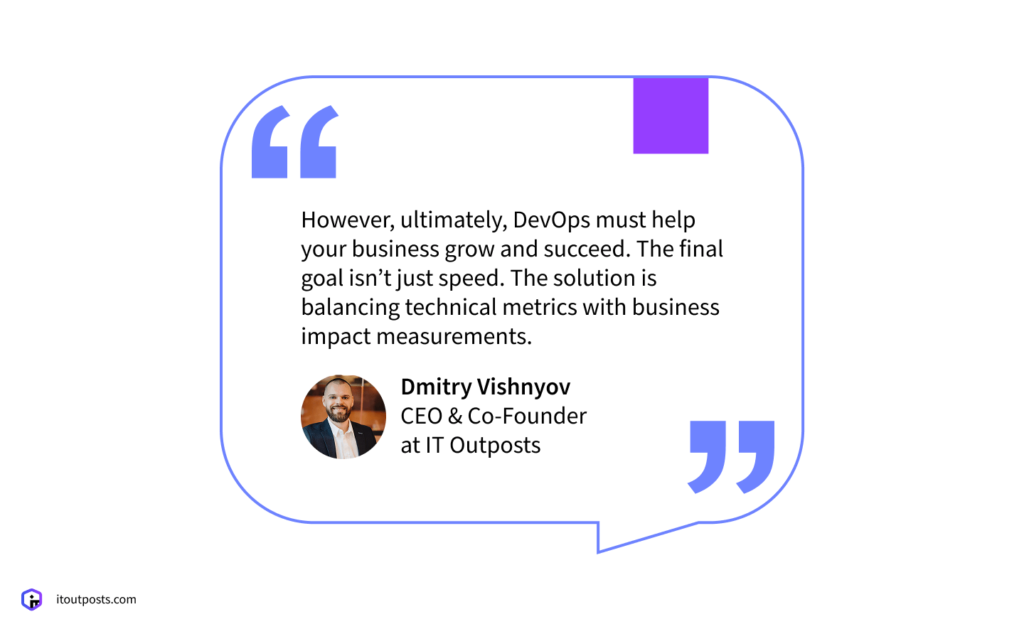Contents
DevOps aims to solve some of the biggest challenges that tech companies face. It lets them achieve faster time to market, less downtime, and lower operational costs.
So organizations take the DevOps route. They invest in automation tools, hire DevOps engineers, and start transformation. But months go by, and it seems that efforts and investments aren’t justified.
It’s not because DevOps doesn’t work. When done correctly, it does deliver everything promised and more. However, our practice shows that what holds these companies back is the following mistakes.

1. Buying DevOps Tools Instead of Building a DevOps Culture
DevOps isn’t just about tools; it’s more like a mindset or way of thinking. This might sound a bit abstract at first, but let us explain how the DevOps philosophy works in practice.
In traditional setups, developers write the code, and operations teams handle everything that happens after.
DevOps flips this idea on its head. It encourages everyone to share responsibility for the entire process, from writing the code, to deploying it, to monitoring and fixing issues.
When a developer writes code, they also think about how it will actually work in production. At the same time, operations teams design infrastructure that helps developers build and deploy quickly.
Some organizations skip this philosophical part. They spend on automation platforms and hire experts. Yet, their teams keep working in isolation, focusing mainly on their own department goals, and blame each other when issues come up.
2. Lacking Management Commitment
Developers and operations teams are unlikely to start working together on their own. The right mindset must start at the top—leaders should step in and set the tone.
They should rethink how they measure success, so both teams aim for the same goals. Instead of metrics that often pit teams against each other (like measuring developers on the number of features they deliver every sprint and judging operations on system uptime), they should adopt shared metrics.
These could be KPIs, like lead time from code commit to production, mean time to recovery (average time to fix issues), and customer satisfaction scores.
Leaders also need to break down organizational barriers that keep teams apart. For example, if developers and operations report to different team leads who also don’t communicate well, collaboration becomes very difficult.
It’s better if both teams report to the same team lead, or if they report separately, their managers should have shared goals.
3. Underestimating the Skill Gap
Whether you choose to build an in-house team or outsource your project, it’s important that your engineers are skilled in the specific technologies your project relies on.
DevOps engineers aren’t universal specialists. And they don’t have to know everything.
The field is so vast with different tools and platforms that no single person can be an expert in every area. For example, you have container orchestration tools like Kubernetes and Docker Swarm, CI/CD platforms like Jenkins, GitLab CI/CD, and GitHub Actions, infrastructure as code solutions such as Terraform and Pulumi, monitoring tools like Prometheus and DataDog, and a variety of cloud services like AWS, Azure, Google Cloud, Hetzner, and DigitalOcean.
And the platforms we just mentioned are just the tip of the iceberg:

An engineer might specialize in AWS ECS but have no experience with Kubernetes. So, if you plan to switch from ECS to Kubernetes, you need to make sure you have the right Kubernetes specialist in place.
4. Trying to Transform Everything at Once
There’s a certain charm in the idea of a full DevOps overhaul. It seems to make sense—why prolong the frustration when you could fix everything at once?
However, in a DevOps transformation, you change how people work, how systems connect, and how decisions are made, all while running your business.
Should you move fast, solving multiple problems at the same time, and everyone will get overwhelmed, nothing will be done well, and people will start longing for the “good old days” when at least things were predictable.
The smarter way is to focus on one team, one application, or one process at a time and do it right. By learning what works, what doesn’t, and what issues pop up, you receive valuable experience. With these lessons, you can then proceed with the next task.
5. Ignoring Legacy System Complexity
Trying to transform everything at once is particularly challenging if you have a legacy system.
Legacy systems are systems built using outdated technologies and practices. And they frequently have hidden dependencies that only become apparent when you attempt to make changes.
There can also be a lack of documentation, or it’s absent completely, because the initial engineers have offboarded, taking their knowledge with them.
Yet, such systems often run critical business functions. And this creates a dangerous situation.
You can’t afford to break systems that handle customer data, payments, and other essential operations. Testing changes is also complicated because these older systems were unlikely to have been designed with modern methods like automated testing or staging environments in mind. A single mistake could lead to revenue loss and damage customer trust.
Therefore, again, the only way here is to shift to the DevOps best practices gradually, migrating to the new foundation one service at a time.
6. Building Disconnected Toolchains
Organizations also frequently accumulate too many disconnected tools. For example, a team might find one tool that handles a specific task well. Then they add another for monitoring the system, then another for deployment, and yet another for security.
The problem is that they rarely plan how these tools work together. Each decision tends to be made in isolation.
As a result, when tools aren’t properly integrated, your team may still have to do extra manual work, which takes more time. Without integrated data, it’s nearly impossible to get a complete picture of your system’s health. What’s worse, you risk overpaying for tools that may have overlapping functionality.
A more effective approach is to develop a clear tool strategy before investing in new solutions. Define what data needs to flow between systems, choose tools that have good integration capabilities.
Sometimes, it’s worth selecting a slightly less perfect tool if it plays well with your existing stack.
7. Overlooking Future Growth
Similarly, some companies make technology decisions based on their current needs, without looking ahead and thinking about their business in two or three years. They often pick solutions that work well for their current team size and traffic, but then run into problems as they try to grow.
So, how can this be avoided? It’s helpful to work with DevOps teams who understand not just the technical details but also how technology aligns with your overall business goals. They should ask questions about your growth plans, expected traffic, and team expansion. This way, they can recommend solutions that will scale with you.
The best approach is to bring in a solution architect early on. They can help design systems that meet your current needs while also taking into account your plans to expand later, whether you add more services or enter new markets.
8. Focusing on Technical Metrics Only
Deploying ten times a day instead of once a week is indeed an exciting achievement. Other technical metrics like lead time for changes and change failure rate can serve as valuable indicators that your DevOps engineering processes are improving.

Track deployment frequency, but also measure how quickly you resolve customer issues. Monitor infrastructure performance, but also track user engagement and satisfaction scores. Celebrate faster releases, but prove they actually make customers happier and drive more revenue.
Skip the Common DevOps Mistakes and Get Straight to Results
Most DevOps failures happen for similar reasons. But these failures are completely avoidable.
First of all, it’s critical to be patient. As the saying goes, “Big tree is growing slowly”, and trying to rush it is often what causes these failures in the first place.
In addition, at the beginning of your DevOps adoption path, assess what you have right now: your current systems, team dynamics, and business priorities. Then, evaluate your opportunities realistically while thinking about where your business is headed.
We realize you have many pieces to connect simultaneously. It may not always be clear how to balance current business priorities while building a scalable technical foundation.
IT Outposts is here to help.
Whether you’re a startup or an established company, you may benefit from AMIX. This is our pre-built infrastructure with 20+ expertly configured tools that work seamlessly together.
We offer more than a product; we offer a solution created based on our own failures and successes. AMIX saves 160+ engineering hours and handles 10x growth.
Contact us today to find out more about AMIX and how it can make DevOps truly work for your business!

I am an IT professional with over 10 years of experience. My career trajectory is closely tied to strategic business development, sales expansion, and the structuring of marketing strategies.
Throughout my journey, I have successfully executed and applied numerous strategic approaches that have driven business growth and fortified competitive positions. An integral part of my experience lies in effective business process management, which, in turn, facilitated the adept coordination of cross-functional teams and the attainment of remarkable outcomes.
I take pride in my contributions to the IT sector’s advancement and look forward to exchanging experiences and ideas with professionals who share my passion for innovation and success.